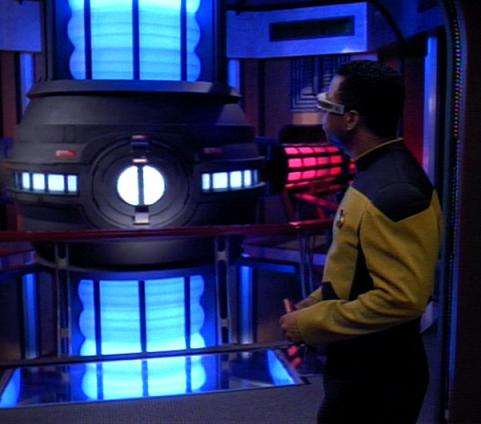


In "True Q"[TNG6], we hear the following exchange occur in Engineering:
Amanda: "It's hard to imagine how much energy is being harnessed in there."
Data : "Imagination is not necessary; the scale is readily quantifiable. We are presently generating 12.75 billion gigawatts per . . . "
At that point, Data is cut off by alarm.
Now we have 3 options:
a) follow the script, which states that Data said "12.75 billion gigawatts per secod" (but which is not canon)
b) assume he was about to say "per pulse"
c) assume he was about do define unit of volume.
a)
Since gigawatt is gigajoule per second, then x gigawatts per second will actually mean that power production will increase every second by x gigawatts, which is nonsensical. However, journalists (and, it seems, script-writers) occasionally use "watts per second" where they should use simple watts. Which means that we can simply ignore "per second" part and get power production of 12.75 billion gigawatts.
b)
As we can see in this video, warp core reaction goes in pulses; when Data made his statement, warp core was generating 1 pulse per second; however, there was space for one more pulse between two pulses. 1 pulse lasted 1/2 of second, with same time of "empty" space between. So total output of E-D's core should be 6.375 billion GJ per reaction, or 3.1875 billion GW total.
c)
Brent Spiner, who plays Data, is 1.778 meters tall. Eyeball estimate of warp core diameter gives us around 90 centimeters in diameter; however, part containing fuel is more like 54 cm in diameter. Matter-antimatter reaction seems to go in pulses, 1 pulse per second, with pulse length of around 100 centimeters for volume of 0.229022 cubic meters. Given that 2 pulses react with each other, that volume is 0.458044 cubic meters.
If we take deuterium/antideuterium, that is total reactant mass of 0.08 kg per second or 59 545 720 kilograms of ultra-dense deuterium and its antimatter equivalent per second.
So we can calculate standard energy output of 7.2 x 10e15 watts or 7.2 PW for standard deuterium or 5.36 x 10e24 W (5 360 000 000 PW) for super-dense deuterium.
12.75 billion GW is 1.275 x 10e19 joules per second, which translates into 141.86 kilograms of fuel annihilated. Ultra-dense deuterium has density of 140 kilograms per cubic centimeter.
1 billion gigajoules is roughly 239 megatons. So we have outputs of 3.047 gigatons per second, 762 megatons per second and 1.281 petatons (1281 teratons or 1 281 000 gigatons) per second, respectively. Due to photon torpedoes being around 500 megatons, last value is not likely. Actually, since ship is moving at impulse, and does not use any of tactical systems, I think that second (and smallest) value is best to use as final result.
CONCLUSION: Standard power output of GCS warp core is 3.2 billion GW, althought 12.75 billion GW is not unlikely (last figure has support in script).
Now we have power production, but it will be interesting to calculate how long starship can run on its own power before refueling, and how much fuel it needs. For that, we need to calculate how much fuel it can store and how long it will take for starship to use it.
First thing is getting how much fuel is spent. We know that average output is 3.2 billion GW, or 3.2 billion GJ per second, with each 2 pulses producing 6.4 billion GJ. If we take effectiveness of reaction as being 40% (due to neutrinos), we get 178 kg of fuel spent per reaction, or 89 kg of fuel spent per second, which is 320 400 kg of fuel per hour.
If we take E-D as being capable of running on its own power for 5 years, then we have total amount of fuel consumed as being 1.4 x 10e10 kg. Ordinary deuterium therefore cannot be used as fuel; fortunately, there is one solution.
So, if we take ultra-dense deuterium, to achieve required mass we need storage of 108 024 092 cubic centimeters or 108 cubic meters of fuel storage. Due to increased power requirements of warp drive and combat operations when compared to impulse flight, total storage volume might be as high as 200 cubic meters, for 26 000 000 000 kg of fuel.
Also, while antimatter needs containment, by using forcefields it probably won't increase size of tank when compared to actual volume used for storage by too much.
According to this page, Galaxy class has volume of 5 820 983 cubic meters, with stardrive being 1 991 416 cubic meters. With high-end estimate for storage of 200 cubic meters, it is only around 0.01 % of total inner volume.
On other hand, we have MSD.

Part that I guess is reactant storage should be 110 or 124 meters in length, with height being between 2 and 5 meters on average. Average width is probably 1/8th of width of GCS (scaled from frontal wiev) or 59.86 meters. That gives total folume of either 13 200 or 37 200 cubic meters, for total reactant mass of either 1 716 000 000 or 4 836 000 000 tons. With total output of 3.2 x 10e18 J, which requires 89 kilograms of fuel per second to sustain, we get total time before refueling as being either 611 or 1722 years, not counting any combat or warp flight, which I guess could drop that time to anywhere between 30 and 86, or 85 and 242 years.
In "The Dauphin", we have this quote:
Data: "Sir, sensors indicate the communication originated from a terawatt source on the planet."
Riker: "That's more power than our entire ship can generate."
Data: "It is what is needed to penetrate the atmosphere."
Some would suggest that it means Galaxy class starship cannot generate more than 1 terawatt of power (which is 0.239 kt per second). However, instead of throwing all other evidence throught window, we need to look at context: since they were talking about communications, then Riker actually stated that entire communications equipment GCS carries cannot generate that much power - which fits with actual episode; also, it is logical that Riker did not bother saying "communications equipment" part, since it is logical from context, and anyone on bridge will undrestand it. Data's statement "It is what is needed to penetrate atmosphere" actually supports my interpretation.
Also, while "watts per second" does mean increase in power, it is often used by journalists when they should use simple "watts".
Another Delta Quadrant race's ship in "Riddles" was able to generate 9 million terawatts (9 billion GW) or 2.15 gigatons/s, and appeared to be just an even match for the medium sized Voyager. Given size discrepancy between Voyager and Big E, 18 to 25 billion GW for high-end GCS power producion is possible.